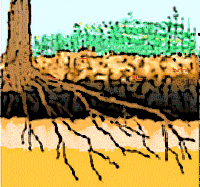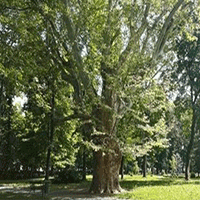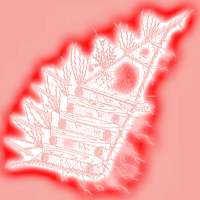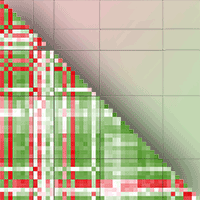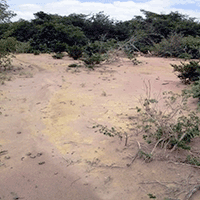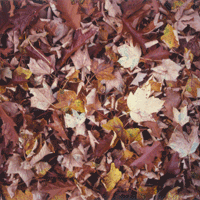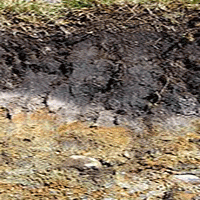The expansion of agricultural, urban and industrial areas in the São Paulo State (SE Brazil) led to the fragmentation of the original semideciduous Atlantic Forest into small, patchy forest remnants. Anthropogenic activities produce a variety of pollutants affecting many ecological processes in these remaining forest fragments through soil acidification and fertilization. In this study, we investigated the soil chemical and physical status of six forest remnants (Paulínia, Holambra, Americana, Jaguariúna, Campinas and Cosmópolis) differently affected by industrial, rural and urban pollution in central-eastern São Paulo in order to determine the soil potential to buffer the inputs of pollutants. Soil samples from 0-10, 10-20 and 20-40 cm depths were collected in the dry and the wet season and the following variables were analyzed: soil texture, pH in CaCl2 solution, exchangeable cations and exchange capacity, organic carbon, total nitrogen, extractable sulfur, phosphorus and heavy metals. Distinct buffering capacities were observed in industrial and in rural and urban areas, primarily due to the natural characteristics of the soils, such as soil texture, acidification and organic matter. The forest soils affected by atmospheric deposition from the industrial complex (Paulínia and Americana) were more sandy and acidic (pH = 3.6) than those near rural and urban sources (pH = 4.5). The optimal chemical conditions (high contents of organic matter, exchangeable bases, nitrogen, phosphorus and sulfur) were found in the clay soils of forest remnants located in Campinas and Jaguariúna, which were more affected by rural or urban pollution than by industrial emissions. Such clay soils provide the highest buffering capacity against environmental impacts in the study region.
Keywords
, , , , ,
Citation
Lopes MIMS, Ribeiro Dos Santos A, Zuliani Sandrin Camargo C, Bulbovas P, Giampaoli P, Domingos M (2015). Soil chemical and physical status in semideciduous Atlantic Forest fragments affected by atmospheric deposition in central-eastern São Paulo State, Brazil. iForest 8: 798-808. - doi: 10.3832/ifor1258-007
Academic Editor
Giustino Tonon
Paper history
Received: Jan 30, 2014
Accepted: Dec 13, 2014
First online: Apr 22, 2015
Publication Date: Dec 01, 2015
Publication Time: 4.33 months
© SISEF - The Italian Society of Silviculture and Forest Ecology 2015
Open Access
This article is distributed under the terms of the Creative Commons Attribution-Non Commercial 4.0 International (https://creativecommons.org/licenses/by-nc/4.0/), which permits unrestricted use, distribution, and reproduction in any medium, provided you give appropriate credit to the original author(s) and the source, provide a link to the Creative Commons license, and indicate if changes were made.

Breakdown by View Type
(Waiting for server response...)
Article Usage
Total Article Views: 54451
(from publication date up to now)
Breakdown by View Type
HTML Page Views: 45455
Abstract Page Views: 3313
PDF Downloads: 4192
Citation/Reference Downloads: 22
XML Downloads: 1469
Web Metrics
Days since publication: 3911
Overall contacts: 54451
Avg. contacts per week: 97.46
Article Citations
Article citations are based on data periodically collected from the Clarivate Web of Science web site
(last update: Mar 2025)
Total number of cites (since 2015): 12
Average cites per year: 1.09
Publication Metrics
by Dimensions ©
Articles citing this article
List of the papers citing this article based on CrossRef Cited-by.
(1)
Akselsson C, Hultberg H, Karlsson PE, Karlsson GP, Hellsten S (2013)Acidification trends in south Swedish forest soils 1986-2008 - slow recovery and high sensitivity to sea-salt episodes. Science of the Total Environment 444: 271-287.
CrossRef |
Gscholar
(2)
Badea O, Bytnerowicz A, Silaghi D, Neagu S, Barbu I, Iacoban C, Iacob C, Guiman G, Preda E, Seceleanu I, Oneata M, Dumitru I, Huber V, Iuncu H, Dinca L, Leca S, Taut I (2012)Status of the Southern Carpathian forests in the long-term ecological research network. Environmental Monitoring Assessment 184: 7491-7515.
CrossRef |
Gscholar
(3)
Binkley D, Son YW, Valentine DW (2000)Do forests receive occult inputs of nitrogen? Ecosystems 3: 321-331.
CrossRef |
Gscholar
(4)
Boruvka L, Mladkova L, Drabek O (2005)Factors controlling spatial distribution of soil acidification and Al forms in forest soils. Journal of Inorganic Biochemistry 99: 1796-1806.
CrossRef |
Gscholar
(5)
CETESB (2012)Relatório de qualidade do ar no Estado de São Paulo [Air quality report in the State of Sao Paulo]. Series Reports, CETESB, São Paulo, Brazil, pp. 125. [in Portuguese]
Online |
Gscholar
(6)
Chrastný V, Vanek A, Teper L, Cabala J, Procházka J, Pechar L, Drahota P, Penížek V, Komárek M, Novák M (2012)Geochemical position of Pb, Zn and Cd in soils near the Olkusz mine/smelter, South Poland: effects of land use, type of contamination and distance from pollution source. Environmental Monitoring Assessment 184: 2517-2536.
CrossRef |
Gscholar
(7)
Cools N, Des Vos B (2011)Availability and evaluation of European forest soil monitoring data in the study on the effects of air pollution on forests. iForest 4: 205-2011.
CrossRef |
Gscholar
(8)
Cools N, Vesterdal L, Des Vos B, Vanguelova E, Hansen K (2014)Tree species in the major factor explaining C:N ratios in European forest soils. Forest Ecology and Management 311: 3-16.
CrossRef |
Gscholar
(9)
Cotrufo MF, Santo AV, Alfani A, Batoli G, Cristofaro A (1995)Effects of urban heavy metal pollution on organic matter decomposition in
Quercus ilex L. Woods. Environmental Pollution 89: 81-87.
CrossRef |
Gscholar
(10)
Domingos M, Klumpp A, Klumpp G (2003)Disturbances to the Atlantic Rainforest in Southeast Brazil. In: “Air pollution impacts on crops and forests: a global assessment” (Emberson L, Ashmore M, Murray F eds). Imperial College Press, London, UK, pp. 287-308.
Online |
Gscholar
(11)
Domingos M, Bulbovas P, Camargo CZS, Aguiar-Silva C, Brandão SE, Dafré-Martinelli M, Dias APL, Engela MR, Gagliano J, Moura BB, Alves ES, Rinaldi MCS, Gomes EP, Furlan CM, Figueiredo AMG (2015)Searching for native tree species and respective potential biomarkers for future assessment of pollution effects on the highly diverse Atlantic Forest in SE-Brazil. Environmental Pollution 202: 85-95.
CrossRef |
Gscholar
(12)
EMBRAPA (1997)Manual de métodos de análise de solo [Manual methods of soil analysis] (2nd edn). EMBRAPA-CNPS, Centro Nacional de Pesquisas de Solos, Rio de Janeiro, Brazil, pp. 212. [in Portuguese]
Online |
Gscholar
(13)
Falkengren-Grerup U, Tyler G (1993)Experimental evidence for the relative sensitivity of deciduous forest plants to high soil acidity. Forest Ecology and Management 60: 311-326.
CrossRef |
Gscholar
(14)
Farr C, Skousen J, Edwards P, Connolly S, Sencindiver J (2009)Acid soil indicators in forest soils of the Cherry River Watershed, West Virginia. Environmental Monitoring Assessment 158: 343-353.
CrossRef |
Gscholar
(15)
Feller C, Beare MH (1997)Physical control of soil organic matter dynamics in the tropics. Geoderma 79: 69-116.
CrossRef |
Gscholar
(16)
Ferretti M, Fischer R, Mues V, Granke O, Lorenz M (2010)Basic design principles for the ICP forests monitoring networks. In: “Manual on methods and criteria for harmonized sampling, assessment, monitoring and analysis of the effects of air pollution on forests”. UNECE ICP Forests Programme Co-ordinating Centre, Hamburg, Germany, Part II, pp. 4-22.
Online |
Gscholar
(17)
Filizola FF, Gomes MAF, Souza MD (2006)Manual de procedimentos de coleta de amostras em áreas agrícolas para analise da qualidade ambiental: solo, água e sedimentos [Manual of sample collection procedures in agricultural areas for environmental quality analysis: soil, water, and sediment]. EMBRAPA Meio Ambiente, Jaguariúna, Brazil, pp. 169. [in Portuguese]
Gscholar
(18)
Forzza RC, Baumgratz JFA, Bicudo CEM, Canhos DAL, Carvalho AA, Coelho MAN, Costa AF, Costa DP, Hopkins MG, Leitman PM, Lohmann LG, Lughadha EN, Maia LC, Martinelli G, Menezes M, Morim MP, Peixoto AL, Pirani JR, Prado J, Queiroz LP, Souza S, Souza VC, Stehmann JR, Sylvestre LS, Walter BMT, Zappi DC (2012)New Brazilian floristic list highlights conservation challenges. BioScience 62: 39-45.
CrossRef |
Gscholar
(19)
Fujii K, Hartono A, Funakawa S, Uemura M, Sukartiningsih Kosaki T (2011)Acidification of tropical forest soils derived from serpentine and sedimentary rocks in East Kalimantan, Indonesia. Geoderma 160: 311-323.
CrossRef |
Gscholar
(20)
Gao W, Cheng S, Fang H, Chen Y, Yu G, Zhou M, Zhang P, Xu M (2013)Effects of simulated atmospheric nitrogen deposition on inorganic nitrogen content and acidification in a cold-temperate coniferous forest soil. Acta Ecologica Sinica 33: 114-121.
CrossRef |
Gscholar
(21)
Hawkins JL, Sheppard MI, Jorgensen SS (1995)Predicting soil lead migration: how can ancient church roofs help? Science of the Total Environment 166: 43-53.
CrossRef |
Gscholar
(22)
Horswill P, O’Sullivan O, Phoenix GK, Lee JA, Leake JR (2008)Base cation depletion, eutrophication and acidification of species-rich grasslands in response to long-term simulated nitrogen deposition. Environmental Pollution 155: 336-349.
CrossRef |
Gscholar
(23)
Hovmand MF, Kemp K, Kystol J, Johnsen I, Riis-Nielsen T, Pacyna JM (2008)Atmospheric heavy metal deposition accumulated in rural forest soils of southern Scandinavia. Environmental Pollution 155: 537-541.
CrossRef |
Gscholar
(24)
Härdtle W, von Oheimb G, Friedel A, Meyer H, Westphal C (2004)Relationship between pH-values and nutrient availability in forest soils - the consequences for the use of ecograms in forest ecology. Flora 199: 134-142.
CrossRef |
Gscholar
(25)
Hédl R, Petrík P, Boublík K (2011)Long-term patterns in soil acidification due to pollution in forest of the Eastern Sudetes Mountains. Environmental Pollution 159: 2586-2593.
CrossRef |
Gscholar
(26)
Högberg P, Fan H, Quist M, Binkley D, Tamm CO (2006)Tree growth and soil acidification in response to 30 years of experimental nitrogen loading on boreal forest. Global Change Biology 12: 489-499.
CrossRef |
Gscholar
(27)
Jobbágy EG, Jackson RB (2001)The distribution of soil nutrients with depth: global patterns and the imprint of plants. Biogeochemistry 53: 51-77.
CrossRef |
Gscholar
(28)
Joslin JD, Wolfe MH (1992)Red spruce soil solution chemistry and root distribution across a cloud water deposition gradient. Canadian Journal of Forest Research 22: 893-904.
CrossRef |
Gscholar
(29)
Kabala C, Szerszen L (2002)Profile distributions of lead, zinc, and copper in Dystric Cambisols developed from granite and gneiss of the Sudetes Mountains, Poland. Water, Air, and Soil Pollution 138: 307-317.
CrossRef |
Gscholar
(30)
Ke-Hui L, Yun-Ting F, Fang-Ming YU, Qiang L, Fu-Rong L, Shao-Lin P (2010)Soil acidification in response to acid deposition in three subtropical forests of subtropical China. Pedosphere 20: 399-408.
CrossRef |
Gscholar
(31)
Ker JC (1997)Latossolos do Brasil: uma revisão [Oxisols of Brazil: a review]. Geonomos 5: 17-40. [in Portuguese]
Online |
Gscholar
(32)
Kimetu JM, Lehmann J, Ngoze SO, Mugendi DN, Kinyangi JM, Riha S, Verchot L, Recha JW, Pell AN (2008)Reversibility of soil productivity decline with organic matter of differing quality along a degradation gradient. Ecosystems 11: 726-739.
CrossRef |
Gscholar
(33)
Klumpp A, Domingos M, Klumpp G (2002)Foliar nutrient contents in tree species of the Atlantic Rain Forest as influenced by air pollution from the industrial complex of Cubatão, SE-Brazil. Water, Air, and Soil Pollution 133: 315-333.
CrossRef |
Gscholar
(34)
Leitão Filho HF, Pagano SN, César O, Timoni JL, Rueda JJ (1993)Ecologia da Mata Atl’ntica em Cubatão [Ecology of the Atlantic Forest in Cubatão]. Unesp/Unicamp, São Paulo, Brazil, pp. 184. [in Portuguese]
Gscholar
(35)
Leuschner C, Wulf M, Bäuchler P, Hertel D (2013)Soil C and nutrient stores under Scots pine afforestations compared to ancient beech forests in the German Pleistocene: the role of tree species and forest history. Forest Ecology and Management 310: 405-415.
CrossRef |
Gscholar
(36)
Li XG, Li FM, Zed R, Zhan ZY, Bhupinderpal-Singh X (2007)Soil physical properties and their relations to organic carbon pools as affected by land use in an alpine pastureland. Geoderma 139 (1-2): 98-105.
CrossRef |
Gscholar
(37)
Lucas RW, Klaminder J, Futter MN, Bishop KH, Egnell G, Laudon H, Högberg P (2011)A meta-analysis of the effects of nitrogen additions on base cations: implications for plants, soils, and streams. Forest Ecology and Management 262: 95-104.
CrossRef |
Gscholar
(38)
Materechera SA, Mkhabela TS (2001)Influence of land-use on properties of a ferralitic soil under low external input farming in southeastern Swaziland. Soil and Tillage Research 62: 15-25.
CrossRef |
Gscholar
(39)
Matos AT, Fontes MPF, Costa LM, Martinez MA (2001)Mobility of heavy metals as related to soil chemical and mineralogical characteristics of Brazilian soils. Environmental Pollution 111: 429-435.
CrossRef |
Gscholar
(40)
Mayer R, Liess S, Lopes MIMS, Kreutzer K (2000a)Atmospheric pollution in a tropical rain forest: effects of deposition upon biosphere and hydrosphere. I. Concentrations of chemicals. Water, Air, and Soil Pollution 121: 59-78.
CrossRef |
Gscholar
(41)
Mayer R, Liess S, Lopes MIMS, Kreutzer K (2000b)Atmospheric pollution in a tropical rain forest: effects of deposition upon biosphere and hydrosphere. II. Fluxes of chemicals and element budgets. Water, Air, and Soil Pollution 121: 79-92.
CrossRef |
Gscholar
(42)
Miller EK, Friedland AJ (1994)Lead migration in forest soils: response to changing atmospheric inputs. Environmental Science and Technology 28: 662-669.
CrossRef |
Gscholar
(43)
Miller DE, Watmough SA (2009)Soil acidification and foliar nutrient status of Ontario’s deciduous forest in 1986 and 2005. Environmental Pollution 157: 664-672.
CrossRef |
Gscholar
(44)
Miranda R, Tomaz E (2008)Characterization of urban aerosol in Campinas, São Paulo, Brazil. Atmospheric Research 87: 147-157.
CrossRef |
Gscholar
(45)
Monaci F, Moni F, Lanciotti E, Grechi D, Bargagli R (2000)Biomonitoring of airborne metals in urban environments: new tracers of vehicle emission, in place of lead. Environmental Pollution 107: 321-327.
CrossRef |
Gscholar
(46)
Nagajyoti PC, Lee KD, Sreekanth TVM (2010)Heavy metals, occurrence and toxicity for plants: a review. Environmental Chemical Letters 8: 199-216.
CrossRef |
Gscholar
(47)
Nalon MA, Mattos IFA, Franco GADC (2008)Meio físico e aspectos da fragmentação da vegetação [Physical environment and aspects of vegetation fragmentation]. In: “Diretrizes para a conservação e restauração da biodiversidade no Estado de São Paulo” (Rodrigues RR, Bononi VLR eds). Instituto de Botanica, São Paulo, Brazil, pp. 15-21. [in Portuguese]
Gscholar
(48)
Nriagu JO (1990)Human influence on the global cycling of trace metals. Paleogeography, Palaeoclimatology, Palaeoecology (Global and Planetary Change Section) 82: 113-120.
CrossRef |
Gscholar
(49)
Ok YS, Chang SX, Feng YS (2007)Sensitivity to acidification of forest soils in two watersheds with contrasting hydrological regimes in the oil sands region of Alberta. Pedosphere 17: 747-757.
CrossRef |
Gscholar
(50)
Ostertag R, Marín-Spiotta E, Silver W, Schulten J (2008)Litterfall and decomposition in relation to soil carbon pools along a secondary forest chronosequence in Puerto Rico. Ecosystems 11: 701-714.
CrossRef |
Gscholar
(51)
Pouyat RV, Yesilonis ID, Szalavecz K, Csuzdi C, Hornung E, Korsós Z, Russell-Anelli J, Giorgio V (2008)Response of forest soils properties to urbanization gradients in three metropolitan areas. Landscape Ecology 23: 1187-1203.
CrossRef |
Gscholar
(52)
Prado H (1997)Os solos do Estado de São Paulo: mapas pedológicos [The soils of São Paulo State: pedological maps]. Hélio do Prado, Piracicaba, Brazil, pp. 205. [in Portuguese]
Gscholar
(53)
Raij BV, Quaggio JA, Silva NM (1986)Extraction of phosphorus, potassium, calcium and magnesium from soil by an ion-exchange resin procedure. Communications in Soil Science and Plant Analysis 17: 547-566.
CrossRef |
Gscholar
(54)
Rolim GS, Camargo MBP, Lania DG, Moraes JFL (2007)Classificação climática de Köppen e de Thornthwaite e sua aplicabilidade na determinação de zonas climáticas para o estado de São Paulo [Köppen and Thornthwaite climate classification and its applicability in the climatic zones determination of São Paulo State, Brazil]. Bragantia 66: 711-720. [in Portuguese]
Online |
Gscholar
(55)
Ross DS, Matschonat G, Skyllberg U (2008)Cation exchange in forest soils: the need for a new perspective. European Journal of Soil Science 59: 1141-1159.
CrossRef |
Gscholar
(56)
Ruan XL, Zhang GL, Ni LJ, He Y (2008)Distribution and migration pf heavy metals in undisturbed forest soils: a high resolution sampling method. Pedosphere 18: 386-393.
CrossRef |
Gscholar
(57)
SanClements MD, Fernandez IJ, Norton SA (2010)Soil chemical and physical properties at the Bear Brook Watershed in Maine, USA. Environmental Monitoring Assessment 171: 111-128.
CrossRef |
Gscholar
(58)
Schaaf W, Wecker B, Pan T, Hüttl RF (2004)Changes in top soil properties of forest soils in north-eastern Germany due to long-term element accumulation. Plant and Soil 264: 85-95.
CrossRef |
Gscholar
(59)
Sebesta J, Šamonil P, Lacina J, Oulehle F, Houška J, Buček A (2011)Acidification of primeval forests in the Ukraine Carpathians: vegetation and soil changes over six decades. Forest Ecology and Management 262: 1265-1279.
CrossRef |
Gscholar
(60)
Sharpley A (1995)Identifying sites vulnerable to phosphorus loss in agricultural runoff. Journal of Environmental Quality 24: 947-951.
CrossRef |
Gscholar
(61)
Song F, Gao Y (2011)Size distributions of trace elements associated with ambient particular matter in the affinity of a major highway in the New Jersey-New York metropolitan area. Atmospheric Environment 45: 6714-6723.
CrossRef |
Gscholar
(62)
Stevens CJ, Dise NB, Gowing DJ (2009)Regional trends in soil acidification and exchangeable metal concentrations in relation to acid deposition rates. Environmental Pollution 157: 313-319.
CrossRef |
Gscholar
(63)
Tang JW, Cao M, Zhang JH, Li MH (2010)Litterfall production, decomposition and nutrient use efficiency varies with tropical forest types in Xishuangbanna, SW China: a 10-year study. Plant Soil 335: 271-288.
CrossRef |
Gscholar
(64)
Tresmondi ACCL, Tomaz E (2004)Air pollution and the influence of sources on Paulínia (Brazil) and surroundings. International Journal Environment and Pollution 22: 490-505.
CrossRef |
Gscholar
(65)
Tresmondi ACCL, Tomaz E, Krusche AV (2005)Avaliação de pH e composição iônica das águas de chuva em Paulínia-SP [Evaluation of pH and Ionic composition of rainwater in Paulínia-SP]. Engenharia ambiental 2: 70-84. [in Portuguese]
Gscholar
(66)
Verstraeten A, Neirynck J, Genouw G, Cools N, Roskams P, Hens M (2012)Impact of declining atmospheric deposition on forest soil solution chemistry in Flanders, Belgium. Atmospheric Environment 67: 50-63.
CrossRef |
Gscholar
(67)
Wei X, Hao M, Shao M, Gale WJ (2006)Changes in soil properties and the availability of soil micronutrients after 18 years of cropping and fertilization. Soil and Tillage Research 91: 120-130.
CrossRef |
Gscholar
(68)
Whittinghill KA, Hobbie SE (2012)Effects of pH and calcium on soil organic matter dynamics in Alaskan tundra. Biogeochemistry 111: 569-581.
CrossRef |
Gscholar
(69)
Wilson MA, Burt R, Indorante SJ, Jenkins AB, Chiaretti JV, Ulmer MG, Scheyer JM (2008)Geochemistry in the modern soil survey program. Environmental Monitoring Assessment 139: 151-171.
CrossRef |
Gscholar
(70)
Xiaogai G, Lixiong Z, Wenfa X, Zhilin H, Xiansheng G, Benwang T (2013)Effect of litter substrate quality and soil nutrients on forest litter decomposition: a review. Acta Ecologica Sinica 33: 102-108.
CrossRef |
Gscholar


